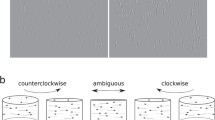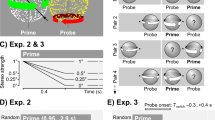Abstract
When confronted with a reversible figure, such as the Necker Cube, viewers experience a spontaneously changing percept. We assess the dynamic of how the human visual system resolves perceptual ambiguity in stimuli that offer multiple interpretations. Subjects observed the Necker cube for one of three viewing durations during which they pressed a key each time they perceived a change in the orientation of the cube. Manipulations of binocular disparity served as a parameter to control perceptual stability. Low-depth conditions yielded more perceptual reversals than high-depth conditions. A Fourier analysis performed on the time series of reversals show 1/f (pink) noise was evident in their power spectra. These results together with theoretical models of complex systems (e.g., Bak, Tang, & Wiesenfeld, 1987) suggest that depth information may guide our perceptual system into a self-organized state to assist us in resolving ambiguous information. Moreover, slopes of the spectra were steeper in high-depth and brief viewing conditions, suggesting that the visual system relies more on previous perceptual states and filters more white noise in these conditions.
Similar content being viewed by others
References
Aks, D. J. ZelinskyG. & SprottJ. C. (2002). Memory across eye-movements: 1/f dynamic in visual search. Nonlinear dynamics, Psychology and Life Sciences, 6, 1–25.
Ash, I. E. (1914). Fatigue and its effect upon control. Archives of Psychology, 31.
Bak, P. (1996). How nature works: The science of self-organized criticality. New York: Copernicus—Springer-Verlag.
Bak, P., & Tang, C. (1989). Earthquakes as a self-organized critical phenomenon. Journal of Geophysical Research-Sol. Earth Planet 94, 15635–15637.
Bak, P., Tang, C., & Wiesenfeld, K. (1987). Self-organized criticality: An explanation of 1/f noise. Physical Review Letters, 59, 381–384.
Bak, P., Tang, C., & Wiesenfeld, K. (1988). Self-organized criticality. Physical Review A 38, 364–374.
Barnsley, M. F., Devaney, B. B., Mandelbrot, H. O., Peitgen, D., Saupe, D., & Voss, R. F. (1988). The science of fractal images. New York: Springer-Verlag.
Bassingthwaighte, J. B., Liebovitch, S. & West, B (1994) Fractal physiology. NY: Oxford Press.
Chen, Y., Ding, M. & KelsoS (1997). Long term memory processes (1/fα Type) in human coordination. Physical Review Letters, 79, 4501–4504.
Clayton, K. & Frey, B. (1997). Studies of Mental ‘Noise’ Nonlinear Dynamics, Psychology and Life Sciences, 1, 173–180.
Cormak, R. H. & Arger, R. (1968). Necker cube perspective dominance as a function of retinal disparity. Perceptual and Motor Skills, 26, 267–370.
Daugman, J. G. (1988). Complete discrete 2-D Gabor transforms by neural networks for image analysis and compression, IEEE Transactions on Acoustics, Speech and Signal Processing, 36, 1160–1169.
Daugman, J. G. (1991). Self-similar oriented wavelet pyramids: Conjectures about neural non-orthogonality. In A. Gorea (Ed.), Representations of Vision. (pp. 27–46). Cambridge: Cambridge University Press.
De Los Rios, P. & Zhang, Y. (1999) Universal 1/f noise from dissipative self-organized criticality models. Physical Review Letters 82, 472–475
Field, D. J. (1993). Scale-Invariance and Self-similar “Wavelet” Transforms: An analysis of Natural Scenes and Mammalian Visual Systems. In M. Farge, (Ed.), Wavelets, Fractals, and Fourier Transforms. (pp. 151–194). Oxford: Clarendon Press.
Gilden, D. L. (1996). Fluctuations in the time required for elementary decisions. Psychological Science, 8, 296–302.
Gilden, D. L. (2001). Cognitive emission of 1/f noise. Psychological Review, 108, 33–56.
Gilden, D. L., Thornton, T., & Mallon, M. (1995). 1/f noise in human cognition. Science, 267, 1837.
Guastello, S. J. (1995) Chaos, catastrophe & human affairs: Applications of nonlinear dynamics to work, organizations and social evolution. Mahwah, NJ: Erlbaum.
Hebb, D. O. (1949). The organization of behavior. Wiley: New York.
Hochberg, J. (1950). Figure-ground reversal as a function of visual satiation. Journal of Experimental Psychology, 40, 682–686.
Howard, I. P. (1961). An investigation of a satiation process in reversible perspective of revolving skeletal shapes. Quarterly Journal of Experimental Psychology, 13, 19–33.
Kelso, S. (1992). Dynamic patterns: The self-organization of brain and behavior. Cambridge: MIT Press.
Kohler, W. (1940). Dynamics in psychology. New York: Liveright.
Liebovitch, L. (1998). Fractals and chaos simplified for the life sciences. Oxford: Oxford University Press.
Long, G. M., Topping, T.C., Kostenbauder, J. F. (1983). As the cube turns: evidence for two processes in the perception of dynamic reversible figure. Perception & Psychophysics, 34, 29–38.
Long, G. M., Topping, T. C., Mondin, G. W. (1992). Prime time: Fatigue and set effects in the perception of reversible figures. Perception & Psychophysics, 52, 609–616.
Mandelbrot, B. (1967). How long is the coast of Britain? Statistical self-similarity and fractal dimension. Science, 156, 636–638.
McClelland, J. L. & Rummelhardt, D. E. (1986). Parallel distributed processing (PDP) models: Explorations in the microsturcture of cognition, Vol 2: Applications. MIT Press: Cambridge MA.
Miller, S. L., Miller, W. M., & McWhorter, P. J. (1993). Extremal dynamics: A unifying physical explanation of fractals, 1/f noise and activated processes. Journal of Applied Physics, 73, 2617–2628.
Miramontes, O., & Rohani, P. (1998). Intrinsically generated coloured noise in laboratory populations. Proceedings of the Royal Society of London B. 265, 785–792.
Musha, T., Sato, S & YamamotoM (1991). Noise in physical systems and 1/f fluctuations. Tokyo: Ohmsha Ltd.
Necker, L. (1832). Observations on some remarkable Optical Phenomena seen in Switzerland, and on an Optical Phenomenon which occurs on viewing a Figure of a Crystal or Geometrical Solid. The London and Edinburgh Philosophical Magazine and Journal of Science (3rd series) 1(5), 329–337.
Ogle, K. N. (1962). Perception of distance and size. In H. Davson (Ed.) The Eye: Vol. 4. Visual optics and the optical space sense. New York: Academic Press.
Orbach, J., Ehrlich, D., & Heath, H. (1963). Reversibility of the Necker cube: An examination of the concept of satiation of orientation. Perceptual and Motor Skills 17, 439–458.
Peak, D., & Frame, M. (1994). Chaos under control: The art and science of complexity. New York: W. H. Freeman and Co.
Peterson, M. & Hochberg, J. (1983). Opposed-set measurement procedure: A quantitative analysis of the role of local cues and intention in form perception. Journal of Experimental Psychology: Human Perception & Performance, 9, 183–193.
Poston, T. & Stewart, I. (1978). Nonlinear modeling of multistable perception. Behavioral Sciences, 23, 318–334.
Press, W. H., Flannery, S. A., Teukolsky, S. A., & Vetterling, W. T. (1986). Numerical Recipes. New York: Cambridge University Press.
Rhodes, C. J., & Anderson, R. M. (1996). Dynamics in a lattice epidemic model. Physics Letters A, 210, 183–188.
Rhodes, C.J., & Anderson, R. M. (1997). Epidemic threaholds and vaccination in a lattice model of disease spread. Theoretical Population Biology, 52, 101–118.
Schmidt, R. C. Beek, P. J., Treffner, P. J. & TurveyM. T. (1991). Dynamical substructure of coordinated rhythmic movements. Journal of Experimental Psychology: Human Perception & Performance 17, 635–651.
Stassinopoulos, D. & Bak, P. (1995). Democratic Reinforcement. A principle for brain function. Physical Review E., 51, 5033.
Sprott, J. C., & Rowlands, G. (1995). Chaos data analyzer. Raleigh, NC: Physics Academic Sofware (American Institute of Physics).
Ta'eed, L. K. Ta'eed, O. & Wright J.E. (1988). Determinants involved in the perception of the Necker cube: An application of catastrophe theory, Behavioral Science, 22, 97–115.
Virsu, V. (1975). Determinants of perspective reversals. Nature, 257, 786–787.
Voss, R. F. (1992). Evolution of long-range fractal correlations and 1/f noise in DNA base sequences. Physical Review Letters, 68, 3805–3808.
Watson, A. B. (1987). Efficiency of an image code based on human vision. Journal of the Optical Society of America, 4, 2401–2417.
Wolfram, S. (1984). Universality and complexity in cellular automata. Physica D, 10, 1–35.
Author information
Authors and Affiliations
Corresponding author
Rights and permissions
About this article
Cite this article
Aks, D.J., Sprott, J.C. The Role of Depth and 1/f Dynamics in Perceiving Reversible Figures. Nonlinear Dynamics Psychol Life Sci 7, 161–180 (2003). https://doi.org/10.1023/A:1021431631831
Issue Date:
DOI: https://doi.org/10.1023/A:1021431631831




